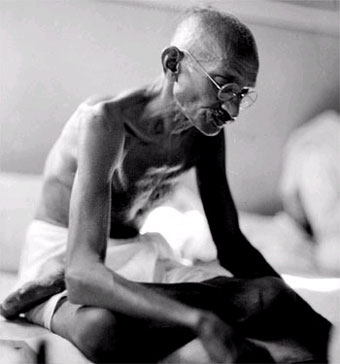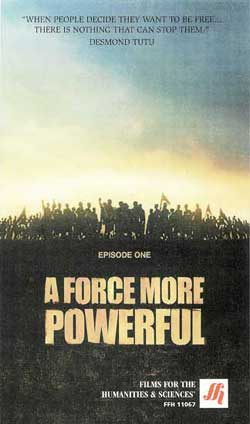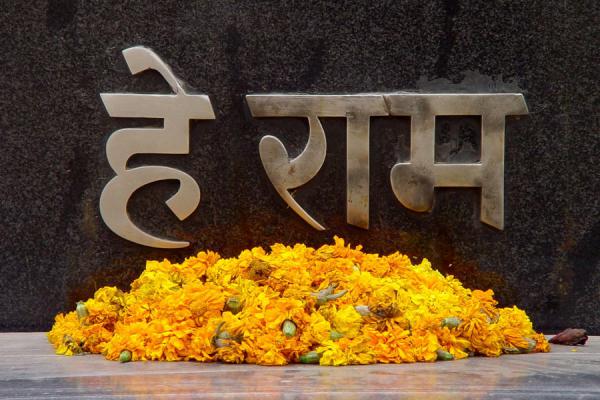
"Holding to Truth, Moving In"
PEACE TEAMS NEWSLETTER, NOV. 1998
by Bill Leicht
After Meeting recently an ex-inmate friend, T. Haywood, stated flatly that he is anti-violent, not non-violent. I believe he meant that transforming violence requires an activism not suggested by the word "non-violence." From my work in the ghettos of New York City, with street youth and in Aikido (a "non-violent" Japanese martial art) I believe that he is on to something
Already in the 1920's M. K. Ghandi's methods were being called "passive resistance." Later "non-violence" became a more common term (still connoting passivity). Gandhi tried to counter this notion by insisting on "satyagraha" or "holding to the truth" as the better name for his methods; its real meaning lay also in "ahimsa," doing no harm. Certainly the image of wave after wave of "satyagrahi" walking up to a police line, then, without striking back, allowing ghurka police to truncheon them to the ground may have startled the West by its disciplined gentleness, but just as certainly Gandhi was actively resisting the British Raj.
Friends Peace Teams, Peace Brigades International and other groups carry on this tradition of civil rights activism. Their non-violent activism still may be misunderstood in part, because of the role of the body.
Anti-violence and the Body
Holding to the truth, we may discern that conflict and violence are physical and perceptible, always, as they are also mental (symbolic and emotional) and spiritual (affecting being itself). Treating them as essentially symbolic, emotional or moral can seem like "whistling in the wind" to those undergoing or emerging from the trauma of war or terror. Nevertheless, most conflict literature and training explore symbolic, social and emotional factors; very few consider the somatic level beyond "body language." However, even verbal violence has a direct and observable effect: e.g., in the first moments of a tongue-lashing an "aggressor" leans forward, then the intended "victim" leans away (further hormonal, postural and behavioral changes may follow and signal changing dominance relationships).
These bodily responses to conflict are "soft-wired" in our nervous system, not "hard-wired" as sometimes maintained; they are malleable with proper training! Surely the Indian Salt March Satyagrahi received intensive physical, mental and spiritual preparation for their suffering. Ghandi said so (I have tried unsuccessfully to discover exactly what that training was). One presumes that yoga was a part of their discipline and that it included breathing, relaxation and concentration. In fact "fight, approach, flight" responses use the same breath, muscle tone and attention that yoga affects (including the central nervous and endocrine systems that control, and are controlled by, them).
We could define "anti-violence" as satyagraha and ahimsa: actively holding to the truth and doing no harm. Anti-violence training then would prepare the body, mind and spirit to take charge of the "fight, approach, flight" responses, rather than be subject to them. What would such training be like physically?
Well, it would look rather like one exercise of the Alternatives to Violence Project ("AVP") "Basic Workshop," the "Hand Pushing Demonstration." In some ways it would resemble hatha yoga. Or, for those familiar with the martial arts, it would look very much like Aikido or Tai Chi.
How can we apply this view of active non-violence (i.e., anti-violence) to those who suffer from war and terror? Strangely, it was a post-Marxist revolutionary, Franz Fanon whose Wretched of the Earth gave me a clue. (3) He discusses at length exactly how "internalization of oppression" (his term) takes place in the oppressor! as well as the oppressed and in the body as well as the mind. For most people, anti-violence responses experienced and learned physically are effective and very memorable.
Assertion: To Center, Join, Approach (Irimi), and Turn
Assertion as well as avoidance and aggression has a physical expression. It is "approach behavior" (or irimi a term we'll clarify below). Avoidance, appears physically, as "flight" or "freeze" behavior. Aggression appears as "fight" behavior. Assertion is more complex than the other two, which may explain why approach requires skillful means while avoidance and aggression seem to come naturally.
That difference arises from the distinction between subject and object. Both aggression and avoidance treat another organism as an object. That is, the purpose of each behavior for the organism is to use the other for its benefit (or safety): eat or be eaten. The purpose of approach is to benefit both parties, challenger and challenged. Reproduction as the most basic of all joining behaviors is its primitive model. At the symbolic and physical levels, subject and object join in one dynamic field, communication. Since assertion considers both parties as subjects or beings, it lies at a more complex and "spiritual" level than aggression or avoidance, not "better," not right for all circumstances, but definitely more complex.
The skillful means in physical assertion involves moving in, but recognizing the being of the other party makes it more complex. This assertion is not simply movement toward an object as English implies, but movement on the physical, mental and spiritual levels simultaneously. The Japanese term irimi better describes physical assertion than "moving in," because it includes the idea of joining, of being-to-being recognition. Irimi also works better than "approach behavior" because it does not imply scientific objectivity and does include spiritual interaction as integral to execution. One skillful means of anti-violence, then, is irimi.
A second means in assertion is "centering." Fortunately in English centering does include physical, mental and spiritual dimensions. For a physical model of centering we have the image of clay spinning before a potter (eloquently developed by M. C. Richards in Centering). Her imagery aptly reflects the sensation of a person moving "on center" in response to a challenge. On the mental level we have the ideas of intellectual and emotional balance. Finally, we find "centering" used to describe the process of deep concentration in worship (Quaker, Zen, Christian, Muslim--all use it).
The skillful means in centering, like irimi, is not obvious. The experience itself is that of letting concentration settle out of the head, leaving behind thought and emotion, and attending to a non-verbal awareness deep in the lower abdomen that does not make distinctions like "physical," mental" or "spiritual."
Developing the skills of irimi and centering is a major focus of the discipline of Aikido. The process of learning and internalizing them is also the process of reversing "internalized oppression." Neuro-muscular traces, including those in the brain and central neuro-hormonal system, may be the reason for most behavior that leads to violence, aggression and subordination or victimization. That implies that the body and its habits are a major source of "moral and immoral behavior," although our language and culture treat morality as primarily mental or spiritual.
Significantly, most moral training emphasizes posture. Prayer and meditation have specific positions. Worship and sacrament have them, too. And we make a verbal-moral distinction between the "upright" and the "crooked" person. How then do we encourage uprightness?
Love is the answer, but getting there is more than repeating, "Love, Love, Love…". When we have "joined" another (especially by recognizing the being of an aggressor), and have approached on "center," we have created most of the conditions for love to flow. The problem is, we may get "hit." Sometimes our joining and approach are such that suffering is a necessary step toward love. Dr. King and Mahatma Gandhi both stressed the redemptive value of suffering (which has deep roots in most religions). However, such suffering isn't always necessary, sometimes it is even counterproductive-- as in most individual violence. In such case love is best served when the aggressor cannot injure the object of aggression.


















